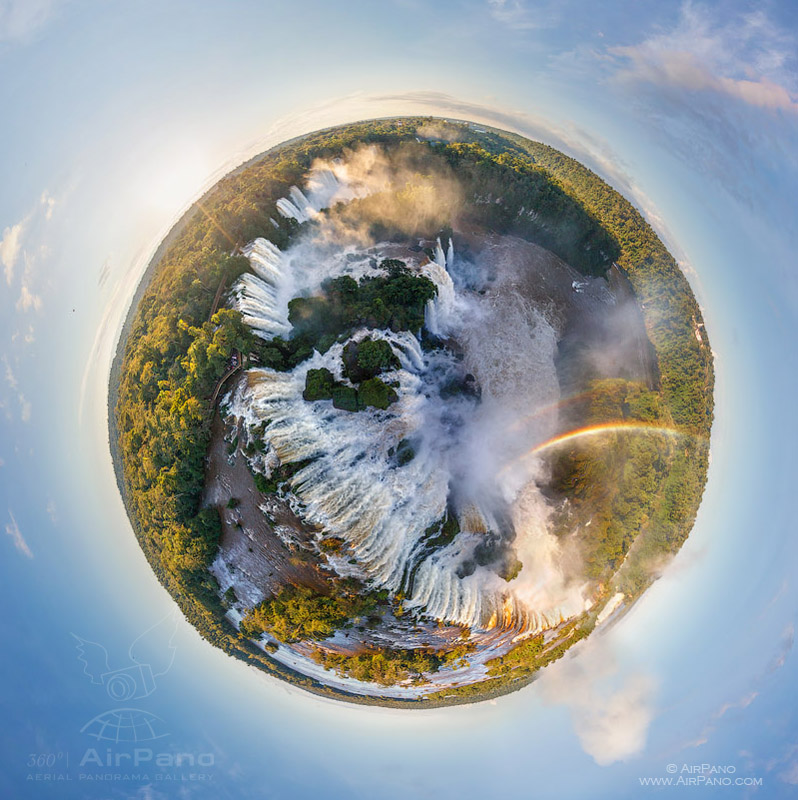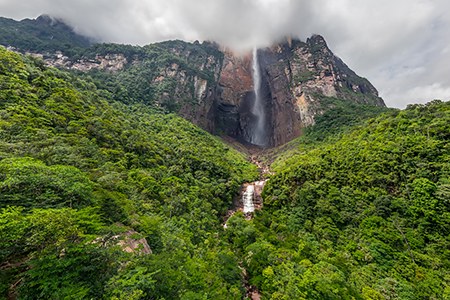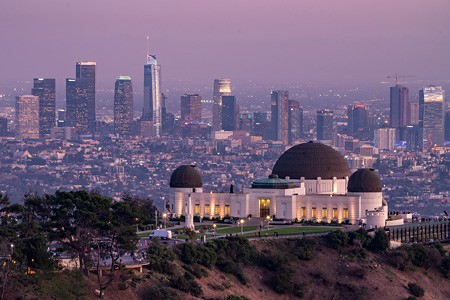Iguazu Falls, Argentina-Brazil. Grand tour
In January 2008 we photographed Iguazu Falls (also known as Iguassu and Iguaçu) located on the border of Argentina and Brazil. This was one of the first AirPano virtual tours. We got only two aerial panoramas in the tour, because of local restrictions for shooting from a helicopter. At that time there was the only helicopter company Helisul, located at the Brazilian side. Unfortunately administration of Brazilian Iguazu Falls Park requested 20 thousand US dollars for a permit to open helicopter doors. Obviously, we didn't have such money, and so I had to struggle shooting spherical panoramas through a small passenger window. Besides, it was prohibited to fly under 500 meters above the waterfalls (which would disturb the nature), as well as crossing the Argentinean border that runs through the middle of the Iguazu River. These restrictions kept our pilot away from most interesting spots of the waterfall.

I took another attempt in a few days. Available helicopter, however, didn't have passenger headphones. I had to cancel the flight, because it was critical to communicate with a pilot during our trip. As I was scheduled to leave Brazil on the following day, the director (an old lady) promised me to refund 500 dollars deposit for the cancelled flight. When I returned to Iguazu Falls a year later, the lady conveniently forgot about her promise and I never got my money back.

It was obvious that a large helicopter was not enough to shoot Iguazu Falls properly (especially from the Argentinean side). We decided to take a second chance and sent our RC helicopter team to Iguazu.
Today we present a large virtual tour that includes aerial and ground photographs. Visitors can see details of Iuazu Falls that were not available for public before from the bird's eye view.
And now I give you Stas Sedov, who personally took part in this photo expedition.
Oleg Gaponyuk
Leaving for Iguazu Falls, Dima and I were worried that it would be a dry season.

Dry season in 2006

Big water in 2005
Our mission was to photograph one of the largest waterfalls in the world, and not a little drip of water. Dima planned our trip very well, carefully selecting travel dates. However, no one could imagine that this would be one of the most stressful and exhausting photo shoots in AirPano history...
Here are selected parts of our email communication with colleagues during the trip:
18 June
I arrived to Iguazu Falls. It rains practically non-stop. There were few gaps in the clouds today, but no sun.
I have never seen so much water in the waterfall basin, even though I have been traveling for 10 years. It pours at 3 million liters per second, and the norm is 1,5 million liters per second...
The waterfall is unbelievably cool! A true endless flow of water!

We will figure out how to shoot the waterfall. We have few ideas, but we worry about our equipment very much. Guys, send us some good weather ASAP! We miss the sun a lot!
19 June
It has been raining non-stop since last night. We went to the observation deck under the waterfall. It was impossible to shoot there! I was soaking wet after running there and back! The viewpoint is practically enveloped in a cloud of mist. We have to take this spot off our location list, unfortunately.
Almost entire canyon is covered with think mist created by falling water. In Moscow, you cannot even imagine the way it looks — it is completely different from older Iguazu spherical panoramas.
20 June
Morning. It's raining again. But we have finally caught our "three rays of sun!"
We have waited for quite awhile on the observation deck; lots of tension, everybody's stressed. There was even more water comparing to the day before. It was risky. At times we flew the helicopter in a thick water mist, maneuvering between heavy clouds. The equipment is still functional. In 15 minutes after our lucky moment it started to rain again, so we wrapped it up.

There was a funny incident later at night. We decided to get a snack while waiting for the sun. Dima bought few packs of cookies and a can of soda in a café near the viewpoint, and left it all on a table. We looked away for a moment and immediately heard a light crunch. We didn't understand what it was at first. Quick look at the table — the cookies are gone! Everything disappeared, but the tail of a little thief running for cover in a nearest shrub. What a vermin! And usually these nosy creatures look so chubby and slow, especially when posing for a camera.
Going to study Iguazu Falls from Argentinean side tomorrow. I checked the footage — there is a chance to get close to the Devil's Throat.
22 June
We have finally shot Iguazu Falls!
It was the most challenging photo shoot — physically and emotionally — of my entire career. Out of five days of our trip the weather favored us only once, today. We have been [censored] exhausted while waiting for the sun to come out!
We have tried practically all weather improving tricks known to men: throwing coins into the water; sacrificing an old flash card to the waterfalls; Dima even made a personal (much more powerful) sacrifice — he quit smoking! (Ok, it was only for the duration of our trip).
I don't know which of the tricks finally worked, and who heard our prayers, but today the sun showed up by the end of the day, even if only for a couple of hours. We did our best to make use of this time and to shoot as many locations as possible from the Argentinean side of the waterfalls. Too bad, we didn't have enough time to photograph everything we wanted.

At night, while processing images, I noticed a peculiar effect — upside-down rainbows! They looked normal from the ground level, but from a higher angle (from a helicopter) a rainbow arches not up, but down. Amazing!
It is raining again outside, so we are going home tomorrow...
23 June
It is late at night, I am writing from the capital of Brazil. We merely made it from Iguazu Falls — as if the waterfall didn't want to let out team go.
Under the morning rain (as you probably guessed by now) we arrived to the airport to learn that our flight was cancelled. They offered us to take a 4PM flight.
Clouds lifted a bit, and sun picked out for a moment. We grabbed out bags and ran back to the park, to the waterfalls. I assembled our helicopter on the floor in a car rental office while Dima signed papers.

When we entered the park, sun was still out, shining bright. We were very excited. Well, as you can easily imagine, the sky got quickly covered with dark clouds with no hope for an outbreak.
After an hour of waiting I proposed to shoot anyway, while waiting for the sun. Agreed — we take off.
The helicopter flew far away from the observation deck — so scary! Ok, it looks like we've got the pictures, time to go back. I land the helicopter and remove the camera to check our "masterpieces." What the hell? The focusing ring was messed up completely. All images can go down the drain.
Alright! I prepare for the next flight. Now we got a strong wind and light rain. We thoroughly check the camera and lens before take off. Everything is fine.

We take off and start shooting. There was a moment when the helicopter almost crashed due a strong turbulence, but we managed to keep it up. We land and remove the camera — what the hell??? All our camera settings were off! The humidity might have caused it, but we didn't care — all images could go down the drain again. The following five minutes were filled with loud cursing in Russian. Finally, I tell Dima "The waterfall simply doesn't want to surrender to us. Let's wrap it up before we crash the helicopter." Dima agreed.
Well, we couldn't help it and stayed for another 15 minutes or so. There was an opening in the clouds. What do you think? We flew one more time.
It was probably the most thorough and precise pre-flight check we have ever done. We checked every single detail three times. While at it, a heavy cloud of mist came from the waterfall and we were forced to take the helicopter higher to keep the lens relatively dry.
Fortunately, this flight went well. We quickly packed our gear and left for the airport under heavy raindrops.
In the airport we found out that our flight was delayed for another hour and a half, so our trip to Iguazu Falls turned to be one day longer. There was no more sunlight. On the way back, when I looked out of an airplane window, everything was covered with clouds. It was raining again at Iguazu...
Photography by Stanislav Sedov and Dmitriy Moiseenko
Iguazu Falls in South America crowns the final stretch of the river bearing the same name. Fifteen kilometers downstream from the waterfalls, the Iguazu River (also known as Iguassu or Iguaçu) empties into another waterway of the continent — the Paraná River. Both create a sort of T-shaped crossroads where the three Latin American states come together: Argentina, Paraguay, and Brazil. Huge frontier markers on the three riverbanks are painted in the national colors of the respective nations.

It is far from being unique that a waterfall creates a state borderline. For example, Niagara Falls is a natural border between the United States and Canada. Yet comparing to Iguazu Falls, the famous Niagara Falls "look like a kitchen faucet," as Eleanor, the wife of the American President Franklin Roosevelt, once said. The First Lady of the United States had not overstated. The height of the Niagara Falls on the Canadian side reaches 53 meters, whereas on the US side (because of piled rocks beneath) it shows only 21 meters. Iguazu Falls, however, drops from the heights of 60 to 80 meters.
It is not surprising that, translated from the language of native Guarani Indians, Iguazu means "big water." Fantastic beauty of the site is multiplied by a colorful rainbow, which can often be seen above the sparkling mist and lush tropical vegetation along both riverbanks. It is believed that Spanish conquistador Álvar Núñez Cabeza de Vaca was the first European to find this natural landmark of South America. He reached the waterfalls in 1541 on his voyage through the jungle up the Paraná River in search of the legendary treasures of Eldorado.

If Iguazu were a single curtain of water, it would be the widest waterfall on the planet. However, this is not the case. Today the title of the widest undivided waterfall in the world belongs to Victoria Falls (1800 meters) in Africa. By the way, it is also a natural border between Zambia and Zimbabwe.
As for Iguazy Falls, it consists of over 270 separate waterfalls with total width of 2700 meters. Numerous islands of different size separate waterfalls. In turn, the islands are connected by footbridges, where one can enjoy a closer view of the falling water. The biggest waterfall of the Iguazu cascade bears a grim name — the Devil's Throat (Garganta del Diablo in Spanish or Garganta do Diabo in Portuguese); it also serves as a border between Brazil and Argentina. The width of "The Throat" is 150 meters, and its length is 700 meters. The shape of the Devil's Throat resembles a horseshoe and includes fourteen powerful waterfalls.
It is interesting that people just recently began using waterfalls for their needs. For example, the Itaipu hydroelectric dam was opened only in 1991. Built by Brazil and Paraguay, the Itaipu Dam generates 12 600 MW powering almost 40% of Brazil and Argentina. The Itaipu Dam is also one of the largest dams in the world; both nations consider it a masterpiece of modern technology.

The Iguazu National Parks located on both sides of the waterfall were designated UNESCO World Heritage Sites in 1984 — 1986. In 2011, Iguazu Falls was announced as one of the winners of the "New Seven Wonders of Nature."
Unfortunately, the Natural Wonder of Iguazu Falls is very fragile. Approximately 1,5 to 3 tons of water flows down the Iguazu Falls every second depending on the season. However, every 40 years a drought turns Iguazu Falls into a basalt cliff. Last time it happened in May — June 1978: not a single drop of water has fallen into the Iguazu chasm for 28 days... On the other hand, major floods fill the waterfall up to the brim. The only waterfall immune to weather in Brazil and Argentina is the infamous "Devil's Throat."

Most of the waterfalls are located on the Argentinean side of Iguazu (2 100 meters long). Being much lower, Brazilian side, however, is considered most spectacular, as one can enjoy a better view of the waterfalls. You have an opportunity to look at the famous landmark of South America from above and see that Iguazu Falls are stunning from every angle.
09 December 2022
Read more
Photogallery The Iguazu Falls #16
The Iguazu Falls #16
 Iguazu Falls
Iguazu Falls
 The Iguazu Falls #4
The Iguazu Falls #4
 Rainbow above Iguazu Falls
Rainbow above Iguazu Falls
 Waterfall Salta Mbigua (Argentine side), cloudy day
Waterfall Salta Mbigua (Argentine side), cloudy day
 After sunset
After sunset
 Iguazu Falls
Iguazu Falls
 Iguassu Falls
Iguassu Falls
 The Iguazu Falls #27
The Iguazu Falls #27
 The Iguazu Falls #19
The Iguazu Falls #19
 The Iguazu Falls #28
The Iguazu Falls #28
 The Iguazu Falls #26
The Iguazu Falls #26

















